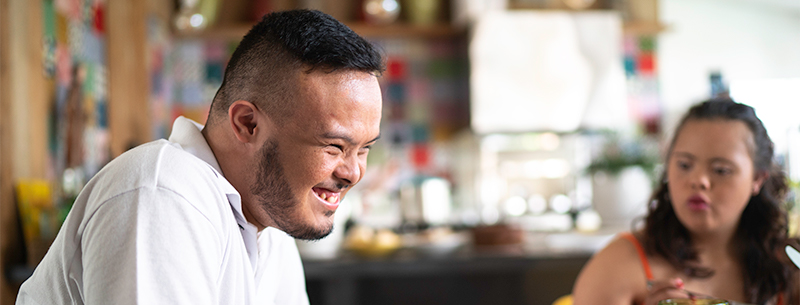Is one of your goals to move out of the family home? Would you like to be more independent in your own home?
Supported Independent Living can help you get there. Supported Independent Living (SIL) is designed to give people with a disability a place they can call home while getting the supports they need to live a full life.
Leap in! has developed a brand new ebook – Supported Independent Living: Achieving your goal to live independently.
Read on for more details about SIL or download your free copy of the ebook now.
What is Supported Independent Living?
Supported Independent Living is a package of NDIS supports designed to help a person with a disability live as independently as possible in a shared living arrangement.
SIL can include all the supports you need to be independent in a home environment such as personal care, assistance with daily tasks or help to get around.
Benefits of Supported Independent Living.
- Freedom and independence
- Share supports with other people
- Not having to live with your family
- Share other costs such as rent and electricity
- Learn new skills.
SIL can help you live independently.
Supported Independent Living (SIL) can be used to get a support worker to help with daily tasks or even do them for you. This can include household tasks such as cooking, or personal care tasks such as bathing.
The support person can also assist you to learn new skills so you can do more things for yourself.
What Supported Independent Living covers.
- Personal care such as getting into or out of bed and getting dressed
- Meal preparation
- Assistance with household tasks including cleaning and grocery shopping
- Tasks associated with running a household
- Help getting around
- Medication management
- Support for managing challenging behaviours
- 24/7 and overnight care.
Top tip: SIL funding does not cover expenses such as rent, electricity, phone, internet, food, household supplies or day-to-day expenses like taxi fares or toiletries.
Choose where you want to live.
The amount of SIL funding included in an NDIS Plan depends on the level of support to live independently in the housing option of your choice.
You can receive SIL funding and live in:
- A rental property
- Your own home or a home your family has purchased for you to live in
- Government or community housing
- Specialist Disability Accommodation (SDA)
- Provider managed accommodation.
SIL may be used in shared living environments with between 2 and 7 people, with costs shared between several NDIS participants.

Supported Independent Living and the NDIS.
Supported Independent Living is referred to as Assistance with Daily Living in the NDIS Core supports budget category.
SIL is a stated support which means the funds have been set aside for a specific purpose and cannot be used for any other purpose.
The amount of funding approved for your SIL arrangement is based on a number of things including:
- The number of people in the shared living arrangement
- The time of day and day of week on which the supports are delivered.
Top tip: Once an SIL package is approved, you are unable to use any other NDIS budgets to pay for items covered by SIL. For this reason, it’s really important that your SIL application includes all the supports you need.
Three levels of SIL funding.
There are three levels of SIL funding available.
- Lower needs: regular support for living arrangements where 24/7 care is not required.
- Standard needs: where more active, 24-hour assistance is required. This includes assistance with and supervision of more tasks and overnight sleepovers by a support worker.
- Higher needs: where continual, complex active assistance is required. Also includes help with managing frequent challenging behaviours.
How to get Supported Independent Living in your NDIS Plan.
SIL is most likely to be included in an NDIS Plan where you have set a goal to live independently and have been working towards this goal for some time.
It is helpful to set living independently as a medium to long-term goal and include that in your NDIS Plan. Then set some short-term goals that can help you reach that goal such as:
- “I want to learn to cook my meals so I can live more independently.”
- “I want to develop my self care skills.”
SIL funding is not flexible so it can only be used for the purpose of Supported Independent Living.
Check out the ebook for more details about the steps you can take to get SIL in your NDIS Plan.
Download your FREE SIL ebook.
Your Leap in! Supported Independent Living ebook contains all this information and more:
- How to get SIL in your NDIS Plan
- Finding a house
- Getting SIL in your own home
- The difference between SIL and Supported Disability Accommodation
- Preparing to live independently in the future.
Further reading
Housing and the NDIS: What your options are.
How to set and achieve your goals.
How to get NDIS plan management.


